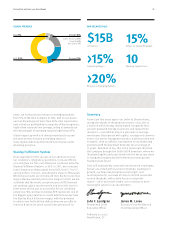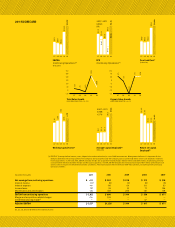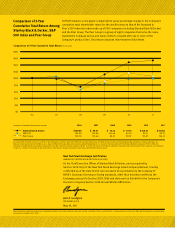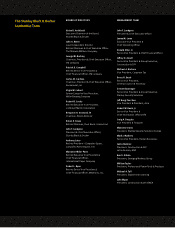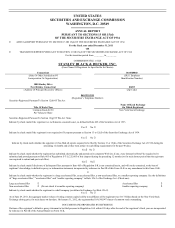Black & Decker 2011 Annual Report Download - page 17
Download and view the complete annual report
Please find page 17 of the 2011 Black & Decker annual report below. You can navigate through the pages in the report by either clicking on the pages listed below, or by using the keyword search tool below to find specific information within the annual report.
5
Major Customers
A significant portion of the Company’s CDIY and Industrial products are sold to home centers and mass merchants in the U.S. and
Europe. A consolidation of retailers both in North America and abroad has occurred over time. While this consolidation and the
domestic and international expansion of these large retailers has provided the Company with opportunities for growth, the increasing
size and importance of individual customers creates a certain degree of exposure to potential sales volume loss. As a result of the
Company’s diversification strategy, sales to U.S. home centers and mass merchants declined from a high of approximately 40% in
2002, to 15% before the Merger. In 2011, sales to U.S. home centers and mass merchants were 18%. As acquisitions in the various
growth platforms (electronic and mechanical security, engineered fastening, infrastructure and healthcare solutions) are made in future
years, the proportion of sales to these valued U.S. and international home center and mass merchant customers is expected to continue
to decrease to pre-Merger levels.
Working Capital
The Company continues to practice the operating disciplines encompassed by the Stanley Fulfillment System (“SFS”). SFS has five
primary elements that work in concert: sales and operations planning, operational lean, complexity reduction, global supply
management, and order-to-cash excellence. The Company develops standardized business processes and system platforms to reduce
costs and provide scalability. SFS is instrumental in the reduction of working capital evidenced by the improvement in working capital
turns for legacy Stanley from 4.6 in 2003 to 8.6 at the end of 2009, directly preceding the merger. Closing out 2010, once blended
with the legacy Black & Decker working capital turns of 4.7, working capital turns for the combined company were 5.7. The
opportunity to deploy SFS across the entire combined enterprise and increase turns represented a significant opportunity to generate
incremental free cash flow. Through the initial integration of the legacy Black & Decker businesses and the ongoing improvement of
the legacy Stanley businesses with the SFS model, working capital turns experienced a 23% improvement from the end of 2010 to 7.0
at the end of 2011 (excluding the impact of Niscayah). In 2012 and beyond, the Company plans to further leverage SFS to generate
ongoing improvements both in the existing business and future acquisitions in working capital turns, cycle times, complexity eduction
and customer service levels.
Raw Materials
The Company’s products are manufactured using both ferrous and non-ferrous metals including, but not limited to steel, zinc, copper,
brass, aluminum and nickel. The Company also purchases resins, batteries, motors, and electronic components to use in manufacturing
and assembly operations. The raw materials required are procured globally and available from multiple sources at competitive prices.
The Company employs a supplier risk mitigation strategy in order to identify and address any potential supply disruption associated
with commodities, components, finished goods and critical services. The Company does not anticipate difficulties in obtaining
supplies for any raw materials or energy used in its production processes.
Backlog
Due to short order cycles and rapid inventory turnover in most of the Company’s CDIY and Industrial segment businesses, backlog is
generally not considered a significant indicator of future performance. At February 4, 2012, the Company had approximately $770
million in unfilled orders, which mainly relate to the Company’s Security segment. Substantially all of these orders are reasonably
expected to be filled within the current fiscal year. As of February 5, 2011 and February 6, 2010, unfilled orders amounted to
$705 million and $320 million, respectively.
Patents and Trademarks
No business segment is dependent, to any significant degree, on patents, licenses, franchises or concessions and the loss of these
patents, licenses, franchises or concessions would not have a material adverse effect on any of the business segments. The Company
owns numerous patents, none of which individually is material to the Company’s operations as a whole. These patents expire at
various times over the next 20 years. The Company holds licenses, franchises and concessions, none of which individually or in the
aggregate are material to the Company’s operations as a whole. These licenses, franchises and concessions vary in duration, but
generally run from one to 40 years.
The Company has numerous trademarks that are used in its businesses worldwide. In the CDIY segment, the STANLEY
®
, FatMax
®
,
DEWalt
®
, Black & Decker
®
, Bostitch
®
, Bailey
®
, Powerlock
®
, Tape Rule Case Design
®
, DustBuster
®
, Porter-Cable
®
, and Workmate
®
of
trademarks are material. The STANLEY
®
, BEST
®
, Blick
tm
, HSM
®
, National
®
, Sargent & Greenleaf
®
, S&G
®
Sonitrol
®
, Niscayah
®
,
Xmark
®
, Kwikset
®
, Weiser
®
, and Baldwin
®
trademarks are material to the Security segment. The DEWalt
®
, CRC
®
, LaBounty
®
, MAC
®
,
Mac Tools
®
, Proto
®
, Vidmar
®
, Facom
®
, USAG
®
, and Emhart Teknologies
tm
trademarks are material to the Industrial segment. The
terms of these trademarks typically vary from 10 to 20 years, with most trademarks being renewable indefinitely for like terms.


